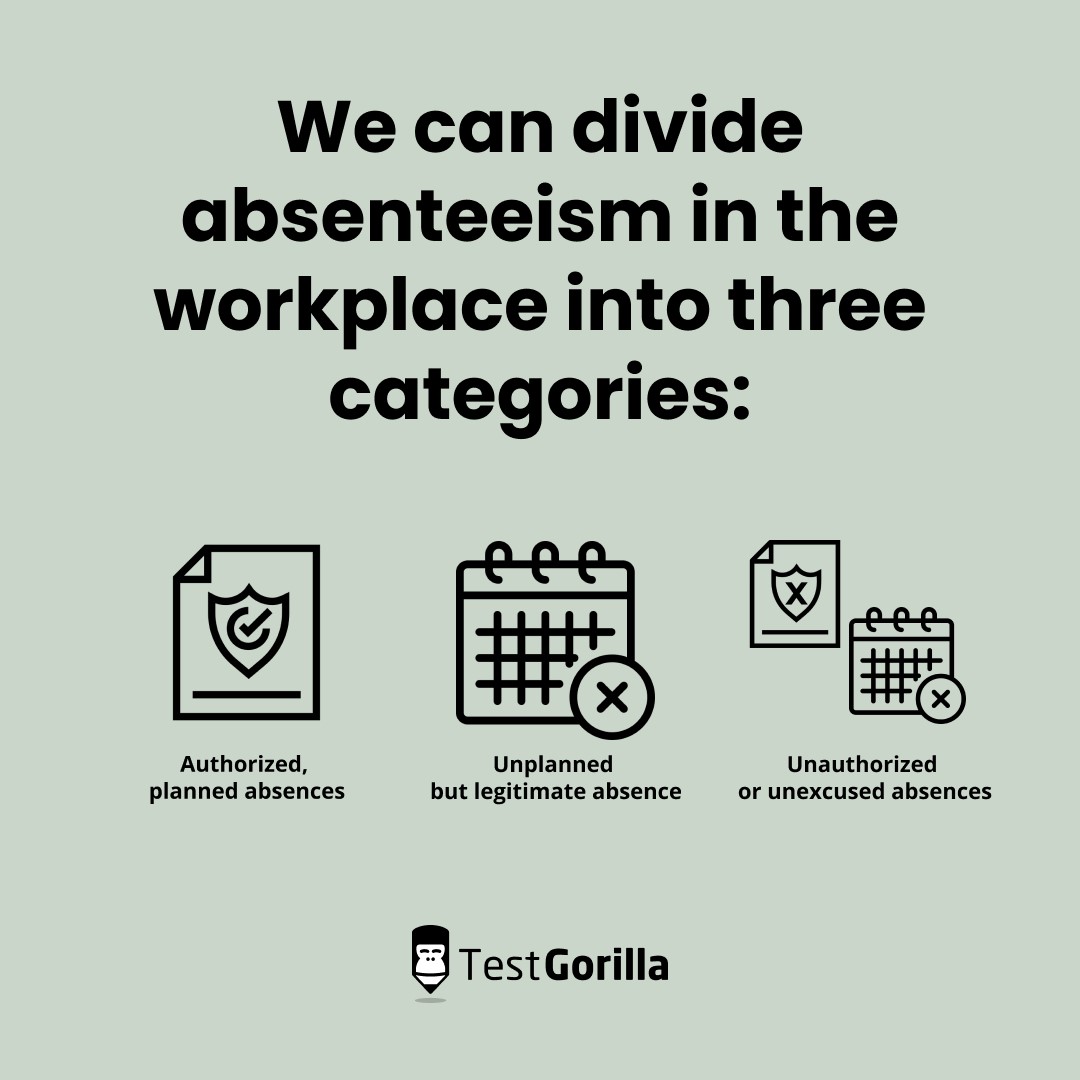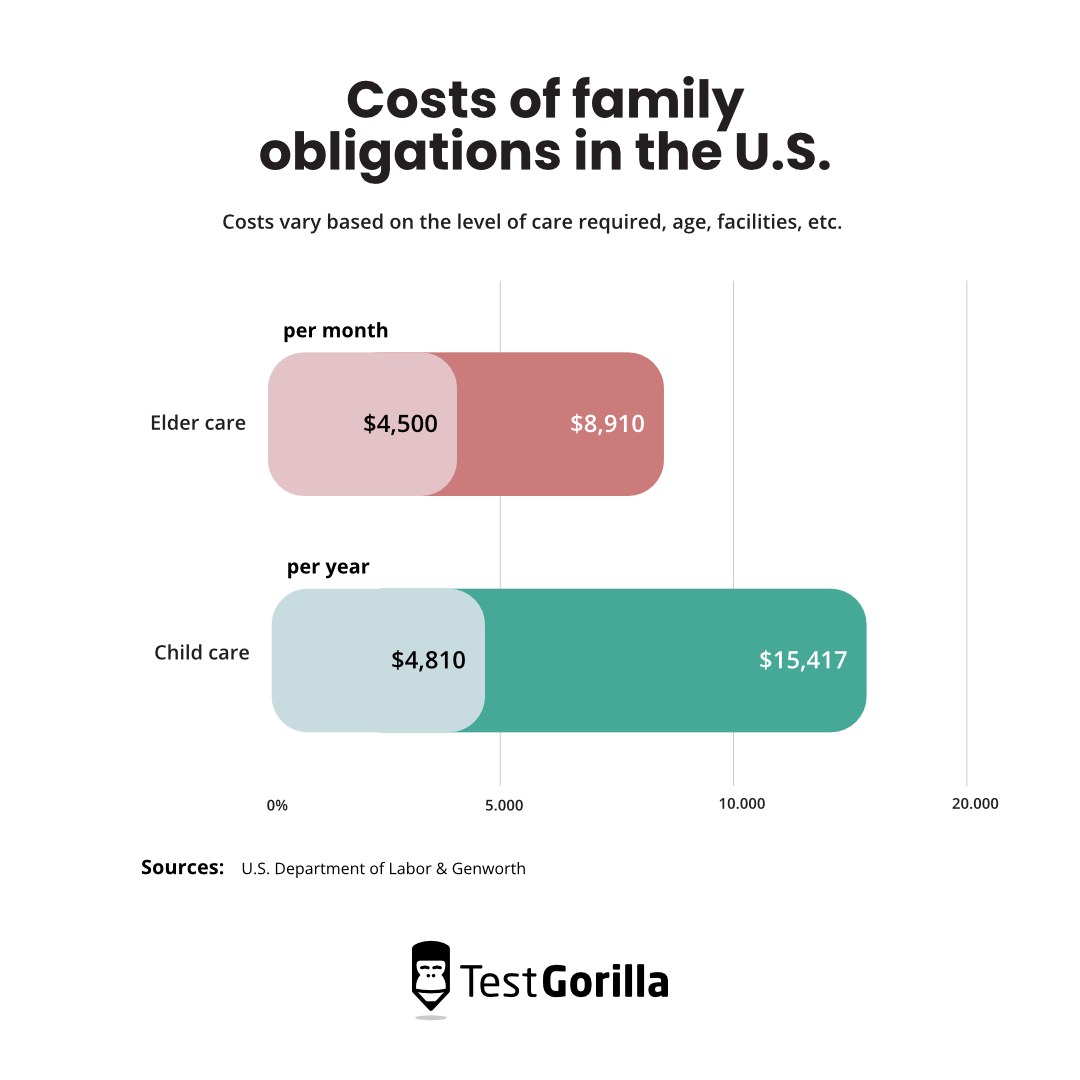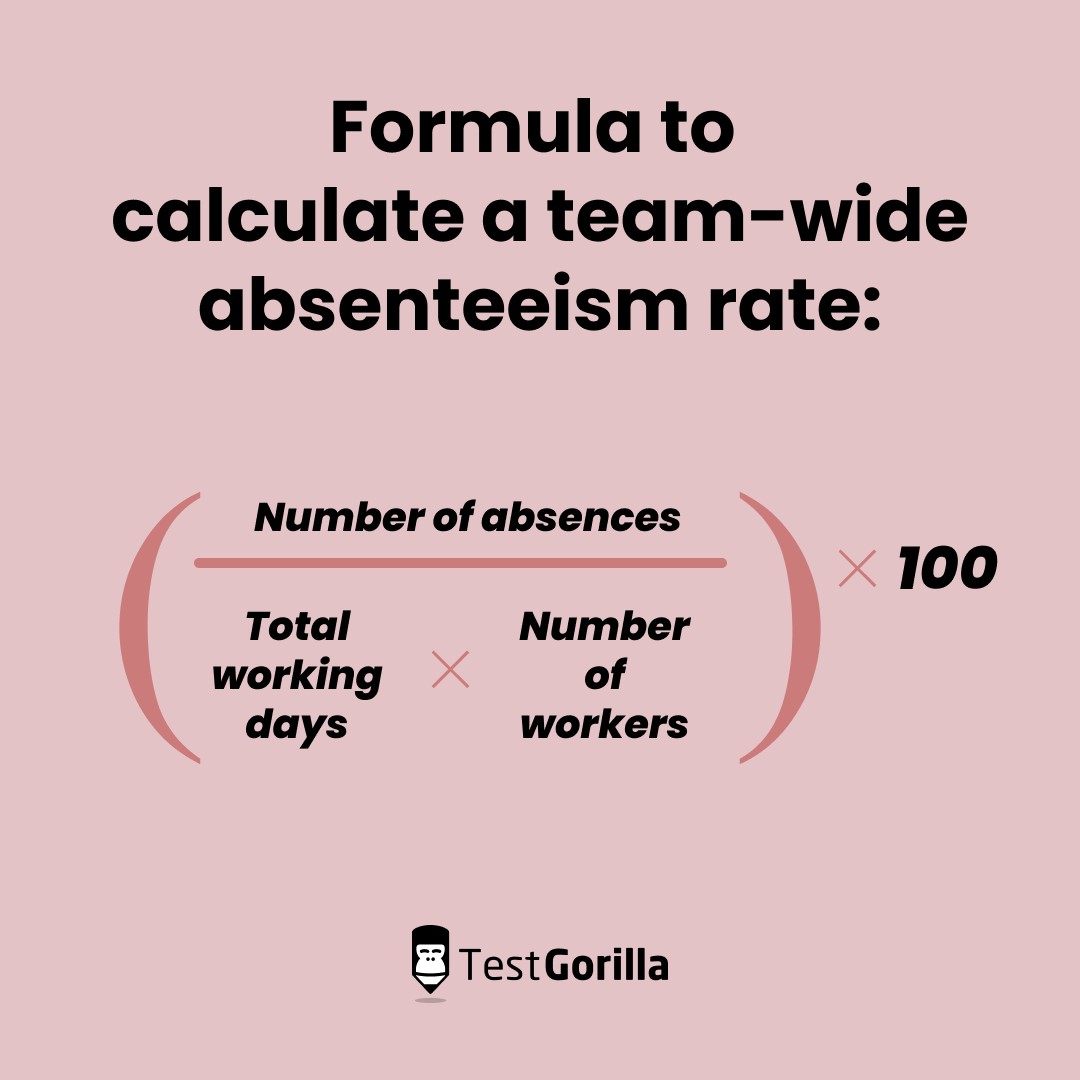You have been understaffed for months. Your sales team’s employee attendance is erratic, and you could miss your quarterly targets.
Worse: Your customers are starting to notice, and they’re frustrated by all the delays.
You want to understand what’s happening in sales to keep employees from coming to work. But it’s flu season, and three people in HR have school-age kids.
Because they don’t have the tools to work from home while their children are ill, you’ve been alone in the office for days. How can you get to grips with what’s going in in your company?
You need to understand the causes and consequences of employee absenteeism.
In this guide, we examine what’s happening – and why – in workplaces like the one in this example. You’ll also learn how to identify excessive absenteeism at work and how to address its root causes and bring it to a minimum.
Table of contents
What is absenteeism in the workplace?
Employee absenteeism is a pattern of behavior in which employees don’t show up to work at the appointed time.
It applies to all types of employees, however many hours they work and whether or not they are salaried.
The occasional unplanned absence isn’t necessarily a problem – most workplaces understand that emergencies happen and are willing to accommodate them.
When employees fall into a pattern of missing work regularly, absenteeism becomes an issue.
When left unchecked, absenteeism has far-reaching consequences that impact every aspect of your business, from employee morale to your company’s bottom line.
The types of absenteeism
Not all employee absences are the same.
In general, we can divide absenteeism in the workplace into three categories:
Authorized, planned absences
Unplanned but legitimate absences
Unauthorized or unexcused absences
An authorized, planned absence is an absence that has been agreed upon between an employee and their workplace ahead of time.
Common reasons for planned absences are vacation leave, prearranged appointments, and parental leave. Federal and state holidays are also authorized planned absences.
Unplanned but legitimate absences happen because of unexpected but genuine problems in an employee’s life.
They could happen owing to illness, family emergencies, commute issues, or even burnout. These absences are challenging for employers but they’re usually hard or impossible to avoid.
An unauthorized absence is an absence that is avoidable, unplanned, and without a genuine cause. These unscheduled absences are seriously disruptive for the entire company.
However, it’s worth remembering that they don’t benefit employees, either – they create a build-up of incomplete work that you eventually need to address.
That’s why it’s worth treating unauthorized absenteeism in your company as a potential warning sign of deeper systemic issues.
Toxic, harmful work environments could push workers into taking unauthorized leave.
Employee absenteeism statistics
Absenteeism is a significant issue in US workplaces.
In 2022, the Bureau of Labor Statistics recorded a 3.6% absenteeism rate among full-time, salaried workers. Absenteeism was highest in the following industries:
Healthcare support (5.5%)
Building and grounds cleaning and maintenance (5.0%)
Personal care and service (4.5%)
Unplanned absences are common among workers who reported fair or poor mental health.
Over 12 months, these workers are estimated to take nearly 12 days of unplanned absences each by comparison to 2.5 days for other workers.
The costs of absenteeism are staggeringly high. Research from the CDC Foundation shows that lost productivity stemming from absenteeism costs US employers $225.8bn – that’s $1,685 per employee.[1]
Unscheduled absenteeism is expensive.
Though the exact figures vary between studies, it’s estimated that unplanned days off cost employers $3,600 per year for each hourly worker and $2,650 per year for each salaried employee.[2]
9 causes of absenteeism at work
Absenteeism has a wide variety of causes, and you must understand what they are so you can tackle them at their source.
Here are the nine most common causes of employee absenteeism.
1. Physical health issues
Employee sickness and injury are common causes of absenteeism and are also hard to control.
Unfortunately, physical health problems can happen to anyone at any time, and sick leave is common.
Yet employees should take time off work to manage sickness and injury. A culture of presenteeism at work risks creating a situation in which employees:
Pass on the sickness to other workers
Make more errors and work less effectively
Experience stress and other forms of psychological harm
Ultimately, it’s usually better for employers to treat absence due to physical health issues as a fact of life.
2. Mental health issues
Mental health issues are a leading cause of employee absenteeism – but they are also much easier for employers to manage than physical health issues.
Employers who can provide workers with support for their mental health and wellbeing are less likely to experience the effects of mental health-related absenteeism.
Even simple steps, like putting boundaries in place with work hours and obligations, can protect employees’ mental health.
3. Family obligations
Employees who are parents or caregivers often need to take excessive absences from work to deal with family emergencies.
Absenteeism because of family obligations is the symptom of a larger problem in the US. Childcare costs across the country range from $4,810 to $15,417 per year, depending on the age and needs of the child, as shown in the graphic below.
Although elder care costs vary based on the level of care required, anyone seeking help from an assisted living facility or nursing home can expect to pay between $4,500 and $8,910 per month.
Most workers whose absences stem from family obligations are already doing what they can to balance caregiving responsibilities with work.
4. Appointments
Employees are people first and foremost, and their lives outside of the workplace frequently need attention.
Because many services are only operational during standard working hours, they sometimes need to schedule appointments during the work day.
Employees need to take time out of work for:
Medical and dental appointments
Home and vehicle repair and maintenance appointments
Legal appointments
Property viewings
Ideally, workers should try to plan these absences where possible – but depending on the nature of the appointment, they won’t always be able to notify employers ahead of time.
A plumbing issue at home, for example, usually needs immediate attention.
5. Commuting problems
Independent vehicles heavily dominate the US commute. The most popular methods of commuting to work in 2021 and 2022 were:[3]
Car (76%)
Public transit (11%)
Bicycle (10%)
But car-based travel is impacted by construction, traffic, collisions, and weather. All of these factors can lead to employee lateness and absences.
Commute-related absenteeism has become less of a problem since the pandemic, which introduced the benefits of remote working.
But as many employers push for a return to office-based working, commuting problems are on the rise as a cause of employee absence.
6. Side hustles
Around 40% of Americans had a side hustle in 2022. On average, people with side hustles spend 13.4 hours on them every week.
Since “side hustle” implies work done alongside an existing job, that figure represents a lot of time diverted from an employee’s full-time work obligations.
Employees with side hustles could take unplanned absences from work to meet the needs of their side jobs.
Over time, those absences affect employers and coworkers – though they yield financial benefits for the absentee workers.
7. Bullying and harassment
One of the most damaging effects of workplace bullying is its impact on absenteeism.
Employees who feel targeted and bullied at work are more likely to become absent employees because they fear coming to work and facing their bully.
Bullying and harassment in the workplace can also lead to quiet quitting, which harms your organization’s productivity and bottom line in the same way as employee absenteeism.
8. Toxic workplace culture
Bullying is just one manifestation of a toxic workplace culture, which can drive absenteeism in its own right. A toxic culture is an environment in which employees:
Don’t trust their leaders or colleagues
Are treated unfairly and inequitably and suffer low morale
Don’t feel appreciated or rewarded for their work
Are unable to strike a healthy work-life balance
Lack opportunities to grow and develop professionally
Feel unable to speak about personal issues affecting them
Employees stuck in this culture are prone to absenteeism because their work environment is psychologically harmful.
Employers must repair their workplace culture to address this type of absenteeism meaningfully.
9. Low engagement
Low engagement is a common symptom of toxic workplace cultures – but it’s also an indicator that workers aren’t aligned with the values and mission of their workplace.
Employees who aren’t interested in or engaged with their work are more likely to take unplanned absences. That’s because they aren’t proactively interested in advancing their work.
Hiring employees based on culture add and motivation is a way to manage low engagement at work. You can find tests that assess these, along with other personality and culture tests, in our test library.
The negative effects of absenteeism in the workplace
Employee absenteeism has a wide range of negative effects that can impact your company.
Here they are, along with how they cause damage:
The consequences | What they mean for your company |
Decreased productivity | Lower innovation and reduced competitiveness against other companies |
Lower quality work | Damage to your company’s public reputation and |
Poor customer service | Harms your company’s long-term relationships with its clients |
Financial costs | Diminished profits, impacting your company’s prospects |
More stress for other employees | Increased absenteeism in the workforce, worsening all of these issues |
Demotivated, demoralized teams | Increased disengagement and among employees |
A toxic workplace culture that harms your ability to attract and |
How to calculate your employee absenteeism rates
Employers can use a few methods to calculate absenteeism rates, depending on the information they want.
The first method generates a straightforward percentage of days spent absent from work over time. Let’s see the formula below:
(Number of absences / Total working days) x 100.
You can adjust the number of absences to reflect only unauthorized or unplanned absences if you want to exclude planned and agreed absences from the final rate.
For example, imagine that James has taken 5 days of absence in 24 days of work.
To find his absenteeism rate over that period, the calculation is (5 / 24) x 100, revealing that James’s absenteeism rate is 20.8%.
If you’re worried about systemic issues impacting a whole team, use a similar formula to calculate a team-wide absenteeism rate:
(Number of absences / (Total working days x Number of workers)) x 100.
For example, say Asif was absent for 4 days in 100 days of work, and his teammates Calla and Rae were each absent for 2 days.
`Their manager would take their 8 total days of absence, divide them by their 300 total days of work, and multiply the result by 100 – to get a much more reasonable team absenteeism rate of 2.6%.
There’s also the Bradford Factor, which takes a more nuanced look at absenteeism over time.
The Bradford Factor considers the number of “spells” of absence over a period, not just the total number of missed days.
It works because a high number of short absences is more disruptive to a workplace than a single long spell of time off.
How to reduce absenteeism in the workplace: 10 proven best practices
Understanding absenteeism is just the beginning. Now, you need to take concrete steps to prevent absenteeism from taking over your company.
These 10 best practices help you to address employee absenteeism at every level.
We explore each one and the specific problems it can help you address.
Reducing absenteeism at a glance
Best practice | How it helps |
Create a robust absenteeism policy | Makes the consequences of absenteeism clear to employees |
Monitor absenteeism rates | Enables managers and leaders to observe any worrying trends and identify their causes |
Increase flexibility | Limits the impact of sickness, appointments, and family emergencies on workflow and efficiency |
Opt for an unlimited PTO policy | Facilitates work-life balance and improves employee wellbeing |
Offer wellness programs | Provides support for employee wellbeing to address mental health absences |
Recognize good work | Improves morale and engagement in the workplace |
Offer upskilling and reskilling opportunities | Fosters engagement by encouraging internal mobility and career progression |
Pay your workers competitively | Builds an engaged workforce with investment in your mission |
Tackle toxic workplace behaviors | Addresses the root causes of absences arising from a toxic workplace culture |
Train managers to offer meaningful support | Empowers managers to address the causes of absenteeism proactively |
1. Create a robust absenteeism policy
The first step to reducing absenteeism is implementing a clear policy on the subject. Your absence policy should contain:
Definitions of different kinds of absence, including tardiness
Acceptable and unacceptable reasons for employee absence
A progression of disciplinary actions and next steps for each type of absence
Your attendance policy should clarify the meaning and consequences of absenteeism for your employees.
By focusing on outcomes instead of inputs as you write your policy, you can get everyone on the same page. That way, nobody can claim ignorance as an excuse if a problem arises.
Once you have a policy, you should promote it widely. Make new hires read it, and have existing workers sign a waiver confirming that they read it and consent to its requirements.
Then make sure you apply it consistently – a policy only works when managers and leaders are willing to apply it.
2. Monitor absenteeism rates
To control absenteeism in your workplace, you need to understand the extent of the problem.
That means gathering data on absenteeism so you can spot any worrying trends and head them off quickly.
You can use the earlier formulas to calculate employee absence rates. But there are plenty of other tools available to you as an HR manager, including:
Timesheets and time reports
Absenteeism tracking spreadsheets
Time and attendance tracking software, including time clock apps
Tracking absenteeism as it occurs is a great way to identify developing issues.
However, it’s also helpful if you need to follow up with an employee about a high absenteeism rate – especially if the situation doesn’t improve and their absence rate stays high.
If you must terminate an employee for excessive absenteeism, you should have thorough documentation of their absences and the reasons for them. If you face a legal challenge from the employee, these documents support your decision.
3. Increase flexibility
Employees want flexibility in either when or where they work – and many would quit their jobs if not offered some degree of flexibility by their employer.
But flexibility has benefits beyond keeping employees happy.
If parents and carers experience family emergencies during regular work hours, a flexible working policy means they can work from home or make up for lost hours later.
Employees with side hustles can use that policy to balance their obligations without losing out.
It’s also helpful for neurodiverse employees prone to mental health-related absences when not accommodated by their employers.
When they can work from places that are comfortable for them, they’re happier and more productive.
Flexibility requires managers to focus on outcomes over inputs. If you trust your workers to meet their work obligations on a schedule that aligns with their needs, you’ll see a drop in absenteeism.
4. Opt for an unlimited PTO policy
Unlimited PTO policies are more mainstream than ever.
Even Microsoft, a major employer, is implementing a “discretionary time off” policy for 2023.
Under these policies, employees can take as many days of paid leave as they need as long as they fulfill the responsibilities of their role.
When implemented correctly, unlimited PTO policies promote a healthy work-life balance and support employee wellbeing.
But if your company culture values “hustling” in a way that promotes competition between workers, workers could feel pressured to avoid using their PTO.
They could take fewer vacation days – which could result in more unauthorized, unplanned absences.
To ensure your unlimited PTO policy works as intended, you must build a positive company culture that values collaboration over competition. In a healthy culture, employees should feel empowered to use their PTO responsibly.
5. Offer wellness programs
Many US workers believe their employer doesn’t care about their wellbeing.
In its own right, that lack of trust in an employer’s good intentions is enough to drive employee disengagement and absenteeism.
But employee wellbeing is a problem in its own right. Beyond the negative impacts of poor mental health on workers’ attendance rates, low wellbeing can escalate into employee burnout.
Recovering from burnout takes time and extensive rest – which usually means a high level of workplace absence during recovery.
Wellness programs you can consider offering your employees include:
On-site fitness facilities and classes
Yoga, meditation, and mindfulness classes
Visits from massage therapists
Access to mental health support services
6. Recognize good work
Employees feel more engaged at work when their work is recognized and rewarded.
It’s a way for employers to show them that they are valued members of a larger team and encourage them to continue giving their best.
When workers feel appreciated and engaged, they’re less likely to slip into a pattern of absenteeism.
So, how can you recognize your employees’ efforts? Here are a few approaches:
A rewards and incentives scheme
Personal thank-you notes for good work
Direct praise and thanks from managers in 1:1 meetings
A culture that encourages peer-to-peer recognition
Find the approaches that work best for your company and implement them consistently.
7. Offer upskilling and reskilling opportunities
Opportunities to upskill and reskill at work show employees that their employer values their professional development.
Offering workplace training is an investment in your workers over the long term – it shows that you’re interested in helping your people develop professionally.
When used right, upskilling and reskilling programs encourage internal mobility within your organization.
They help employers fill skill gaps without the expense and stress of hiring externally, and offer long-term prospects to existing workers.
Many workers leave their jobs because they felt there are limited opportunities to advance their careers.
A sense of stagnation at work leads to low employee engagement, which drives up employee absenteeism.
Keep your workers engaged by giving them the resources they need to develop and advance within your organization.
8. Pay your workers competitively
Employees are more aware than ever of the value of their work.
The Pew Research study above found that 63% of workers cited low pay as influencing their decision to quit their jobs in 2021.
An employee’s pay rate has a direct impact on their level of engagement at work – and low engagement is a known driver of absenteeism.
That’s why you must offer your workers a competitive compensation package.
It shows your workers that you understand and respect their worth, which leads to higher morale, engagement, and productivity in the workplace.
To build a competitive pay and benefits package, use online tools to research salary ranges for employees in your industry and local area.
Remember, employees value benefits as well as a high base salary. Consider the value of any benefits you offer when deciding what competitive compensation looks like for your company.
9. Tackle toxic workplace behaviors
Nobody wants to spend a full working day in a toxic environment.
When showing up to work involves dealing with an abusive manager, a bullying colleague, or a hypercompetitive “hustle” culture, it’s tempting for workers to stay home instead.
Absences because of toxic behavior usually look like one-off days of unplanned absence instead of extended leave. But as the Bradford Factor shows us, those single days can add to a lot of disruption over time.
These spontaneous sick days are a symptom of toxic behaviors in your workplace. To address them, start by assessing your company culture.
When you have a clearer picture of what happens in your organization, you can implement policy and cultural changes to tackle problematic behavior at work.
This process takes time, and you need to rebuild trust with your employees. But if you make an effort, you’ll see improvements in your company’s productivity, efficiency, morale, and bottom line.
10. Train managers to offer meaningful support
As an HR team member, you can’t be everywhere at once. Other people in your company need to know how to identify problems in the workplace – and what to do about them when they surface.
Managers are in day-to-day contact with workers, and they have the authority to take action.
It’s worth your while to train them to spot potentially problematic behaviors from their employees and to proactively address them.
That doesn’t just mean training managers in conflict resolution. You must be confident they can apply their training compassionately and fairly.
Taking steps to become a trauma-informed workplace gives managers the tools they need to support workers meaningfully.
Likewise, when used smartly, implicit bias training equips managers to provide equitable support to everyone on their team.
This approach empowers you to address cultural issues that lead to absenteeism.
But it also helps employees feel safe and supported at work – and less likely to fall into a pattern of absences when dealing with toxicity.
Address the root causes of employee absenteeism
A certain level of employee absenteeism is unavoidable.
However, to protect your company’s reputation, productivity, and morale, you owe it to your employees to tackle avoidable workplace absences head-on.
When you take a holistic approach to absenteeism, you don’t just treat the symptoms. You address its root causes, whether they’re grounded in your company’s existing policies or culture.
When you take steps to transform how your company works, you can create an environment that keeps workers happy, safe, and engaged. It’s a chance to put your values into practice and build a company that puts its people first.
Next, learn how to hire employees returning to work after a long absence and use pre-employment screening to ensure they’re right for your company.
Sign up for your free plan with us today, or book your free 30-minute live demo to find out how we can help you find the best, most motivated employees.
Sources
“Worker Illness and Injury Costs U.S. Employers $225.8 Billion Annually”. (January 28, 2015). CDC Foundation. Retrieved April 19, 2023.https://www.cdcfoundation.org/pr/2015/worker-illness-and-injury-costs-us-employers-225-billion-annually
“Absenteeism: The Bottom Line Killer”. (n.d.). Circadian. Retrieved April 19, 2023.https://www.circadian.com/images/pdf/CIRCADIAN\_-\_Absenteeism\_-\_Bottom\_Line\_Killer.pdf
Richter, Felix. (May 19, 2022). “Cars still dominate the American commute”. WeForum. Retrieved April 19, 2023.https://www.weforum.org/agenda/2022/05/commute-america-sustainability-cars/
Related posts
Hire the best candidates with TestGorilla
Create pre-employment assessments in minutes to screen candidates, save time, and hire the best talent.
Latest posts
The best advice in pre-employment testing, in your inbox.
No spam. Unsubscribe at any time.

Hire the best. No bias. No stress.
Our screening tests identify the best candidates and make your hiring decisions faster, easier, and bias-free.
Free resources
This checklist covers key features you should look for when choosing a skills testing platform
This resource will help you develop an onboarding checklist for new hires.
How to assess your candidates' attention to detail.
Learn how to get human resources certified through HRCI or SHRM.
Learn how you can improve the level of talent at your company.
Learn how CapitalT reduced hiring bias with online skills assessments.
Learn how to make the resume process more efficient and more effective.
Improve your hiring strategy with these 7 critical recruitment metrics.
Learn how Sukhi decreased time spent reviewing resumes by 83%!
Hire more efficiently with these hacks that 99% of recruiters aren't using.
Make a business case for diversity and inclusion initiatives with this data.























